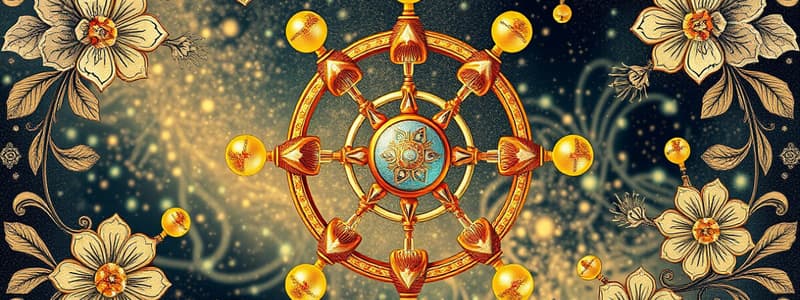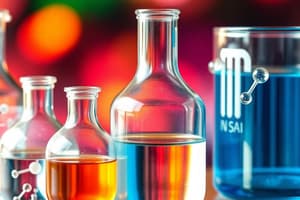Podcast
Questions and Answers
Which of the following forms when atoms share pairs of electrons?
Which of the following forms when atoms share pairs of electrons?
- Covalent bonds (correct)
- Metallic bonds
- Ionic bonds
- Hydrogen bonds
Anions are positively charged ions.
Anions are positively charged ions.
False (B)
What is the primary function of buffers in biological systems?
What is the primary function of buffers in biological systems?
They help maintain a constant pH.
The molecular formula for water is ______.
The molecular formula for water is ______.
Match the following organic molecules with their descriptions:
Match the following organic molecules with their descriptions:
What are the characteristics of phospholipids in cell membranes?
What are the characteristics of phospholipids in cell membranes?
Cholesterol contributes to the fluidity of cell membranes.
Cholesterol contributes to the fluidity of cell membranes.
What type of bond forms between amino acids in proteins?
What type of bond forms between amino acids in proteins?
The __________ structure of a protein refers to its overall 3D shape.
The __________ structure of a protein refers to its overall 3D shape.
Match the types of proteins with their functions:
Match the types of proteins with their functions:
Flashcards are hidden until you start studying
Study Notes
Lesser Elements
- Key elements include calcium, phosphorus, potassium, sulfur, sodium, chlorine, magnesium, and iron.
Structure of Atom
- Atoms consist of a nucleus surrounded by an electron cloud.
- The nucleus contains protons (positively charged) and neutrons (no charge).
- In an uncharged atom, the number of protons equals the number of electrons.
- Anions are negatively charged; cations are positively charged.
Types of Bonds
- Ionic Bonds: Form when one atom transfers electrons, creating a positively and negatively charged ion (e.g., sodium chloride NaCl).
- Covalent Bonds: Atoms share electrons (e.g., methane CH4). Unequal sharing leads to polar molecules (e.g., water H2O). Bonds can be single, double, or triple (e.g., O2 for double).
- Hydrogen Bonds: Weak attractions between polar molecules (e.g., water). Stabilize structures but do not form actual bonds.
Inorganic vs. Organic Molecules
- Inorganic Molecules: Do not contain carbon (e.g., H2O, NaCl, O2) with exceptions like carbon monoxide, carbon dioxide, bicarbonate ion, and methane.
- Organic Molecules: Contain carbon chains covalently bonded to hydrogen and functional groups. Includes carbohydrates, proteins, lipids, and nucleic acids.
Properties of Water
- High heat capacity and high heat of vaporization.
- Dehydration reactions release water; hydrolysis reactions consume water.
- Polarity allows water to dissolve polar substances and form solutions comprised of solutes in solvents.
Salts, Acids, and Bases
- Salts: Release cations and anions when dissolved in water.
- Acids: Release hydrogen ions (protons) in water.
- Bases: Release hydroxyl ions or absorb protons in water.
pH Scale
- pH measures hydrogen ion concentration; biological systems are sensitive to changes.
- Acidic solutions have low pH (e.g., lemon juice, HCl); basic solutions have high pH (e.g., bleach).
- Buffers stabilize pH by absorbing or releasing protons (e.g., bicarbonate ion/carbonic acid).
Organic Molecules
- Comprise a carbon backbone bonded to hydrogen and functional groups.
- Carbohydrates: Made of carbon, hydrogen, and oxygen (C + H2O).
- Monosaccharides: Simple sugars.
- Disaccharides: Two sugars.
- Polysaccharides: Many sugars.
Lipids
- Diverse group of hydrophobic molecules.
- Triglycerides: Composed of glycerol and three fatty acids; found in oils and fats.
- Phospholipids: Contain two fatty acids, phosphate group, and polar molecule, forming lipid bilayers in cell membranes.
- Cholesterol: Stabilizes lipid bilayers; has a rigid structure.
- Steroids: Derived from cholesterol and consist of carbon rings; often act as signaling hormones.
Proteins
- Serve various functions: structural, enzymatic, transport, contractile, communicative, and defensive.
- Made of amino acids (20 types).
- Amino acids linked by peptide bonds formed through dehydration synthesis.
- Protein structure levels:
- Primary: Amino acid sequence.
- Secondary: Folding patterns.
- Tertiary: Overall 3D shape.
- Quaternary: 3D shape of multiple chains.
Enzymes
- Proteins acting as catalysts, facilitating biochemical reactions.
- Bind reactants at the active site to transform them into products.
Nucleic Acids
- Ribonucleic Acid (RNA): Involved in protein synthesis.
- Deoxyribonucleic Acid (DNA): Carries genetic information.
Studying That Suits You
Use AI to generate personalized quizzes and flashcards to suit your learning preferences.



